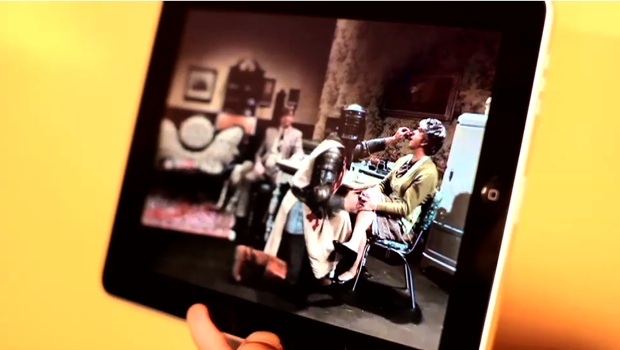Storytelling is so essential to the human condition, even our armpit-scratching ancestors knew how to spin a good yarn. But the ways we tell stories are constantly evolving, as new technologies spark new avenues of communication. The increased predominance of mobile devices—not to mention our clingy dependence on them—has sparked a boom of ambitious apps for phones and tablets that are case studies for storytelling in the “digital age.”Some of these cinematically-leaning apps, like the recent horror flick Haunting Melissa, keep traditional narrative arcs, but incorporate new points of view—like characters filming or video chatting on their own mobile devices. Others, like The Creators Project’s own Energy Flow, take a more—dare I say it—postmodern approach, letting tales unspool in nonlinear and fragmented pieces.Screenshot of the Energy Flow generative film experience, co-produced by The Creators Project and FIELD.Unlike traditional films, these storytelling apps are freed from the constraint of having to unfold in prescribed amounts of time. And many have taken advantage of this looser chronological flow by encouraging—sometimes even requiring—interactivity from the audience, who are no longer allowed to sit back passively, mouths agape. How much participation is required varies greatly—from simply pushing buttons to picking up phone calls from strangers in the middle of the night (but more on that later).New apps seem to pop out of the air every second. And since it’s a Sisyphean feat to keep up with their swelling numbers, here’s the condensed version of how this mobile medium is dramatically altering the ways we tell stories—as well as the very notion of storytelling itself.USING GESTURAL ACTIONS LIKE SWIPING, ZOOMING, AND SHAKINGLet’s not forget that using a phone or a tablet is primarily a physical encounter—where pinching, caressing, and prodding are all required. It’s no wonder so many people carry on love affairs with their shiny little devices.Some apps build these gestures into their own frameworks. In Shadows Never Sleep, a story based on classic children’s tales, the act of “zooming” is a fundamental part of moving the narrative forward. Instead of flipping through pages, you pinch the screen and move into various surfaces—which reveal additional details as you get closer.Still from the Shadows Never Sleep app experience.Sarah and Jerry incorporates even more physical gestures. The interactive film, which is part of a rather awkwardly-named app called Touching Stories, lets you intrude into the characters’ world by flushing their toilets or shaking the screen (earthquaaaaake!), turning your fingers into the literal and invisible hand of God.REPLAYING THE STORY—WITH NEW LAYERS THIS TIMEThe horror industry was shaken up this year by the release of Haunting Melissa, an app-only release from the producer of Mulholland Drive and The Ring. Because the story—of a young woman getting tormented in her creepy house—unfolds over a episodes, the creators had to develop new ways to keep their viewers hooked. Their solution: rewarding their most dedicated fans by adding story elements—like new sounds or visuals—every time their re-watched an episode.Similarly, The Most Interesting Couple in Britain, also part of the Touching Stories app, adds bonus material when a scene is replayed. The material ranges from extra tidbits—like getting to see what the characters (including the dog!) are actually thinking –to altering the very outcome of the story, by choosing between happy, sad, or “random” endings. Still from The Most Interesting Couple in Britain, part of the Touching Stories app.BLEEDING OUT OF THE SCREENApps like Love Synchs—a short film about a young couple who use a new technology to share all their memories—aren’t content with existing within the borders of your screen. They want to barge into your life too. In order to watch Love Synchs, you have to stand next to a friend—or an attractive stranger—who also has a tablet. The film then plays across both your screens, thus extending its theme beyond the narrative and into its very presentation.On a creepier note, two more transmedia films, Last Call and A Journal of Insomnia, let you interact with their characters through phone calls. In Last Call, the so-called “first interactive horror movie,” the film stops in the middle and directs a call to a member of the audience—who gets to direct a character’s actions through giving them a set of commands like “run,” or “stay.”Still from A Journal of Insomnia, an interactive documentary web experience.In order to watch A Journal of Insomnia, you have to get a phone call first from one of the characters in the documentary, which explores the lives of insomniacs all over the world. The catch is that this call only comes in the evening or early morning, which means that you’ll have to stay up all night waiting for it—thus experiencing the nocturnal affliction for yourself. Tough luck.LETTING THE AUDIENCE CREATE THEIR OWN INTEPRPRETATIONSIn 2010 and 2011, The Creators Project supported a generative film app called Energy Flow, conceived and developed by UK-based art and design studio FIELD. The project linked together an international collective of artists who all interpreted a common theme—“how invisible forces and energies shape our world”—with their own styles and perspectives.Each contribution was then weaved together into an expressionistic, non-linear storyline. What’s more, the order that these scenes are presented in change with each replay, letting you construct a narrative from your own loose interpretations.
Still from The Most Interesting Couple in Britain, part of the Touching Stories app.BLEEDING OUT OF THE SCREENApps like Love Synchs—a short film about a young couple who use a new technology to share all their memories—aren’t content with existing within the borders of your screen. They want to barge into your life too. In order to watch Love Synchs, you have to stand next to a friend—or an attractive stranger—who also has a tablet. The film then plays across both your screens, thus extending its theme beyond the narrative and into its very presentation.On a creepier note, two more transmedia films, Last Call and A Journal of Insomnia, let you interact with their characters through phone calls. In Last Call, the so-called “first interactive horror movie,” the film stops in the middle and directs a call to a member of the audience—who gets to direct a character’s actions through giving them a set of commands like “run,” or “stay.”Still from A Journal of Insomnia, an interactive documentary web experience.In order to watch A Journal of Insomnia, you have to get a phone call first from one of the characters in the documentary, which explores the lives of insomniacs all over the world. The catch is that this call only comes in the evening or early morning, which means that you’ll have to stay up all night waiting for it—thus experiencing the nocturnal affliction for yourself. Tough luck.LETTING THE AUDIENCE CREATE THEIR OWN INTEPRPRETATIONSIn 2010 and 2011, The Creators Project supported a generative film app called Energy Flow, conceived and developed by UK-based art and design studio FIELD. The project linked together an international collective of artists who all interpreted a common theme—“how invisible forces and energies shape our world”—with their own styles and perspectives.Each contribution was then weaved together into an expressionistic, non-linear storyline. What’s more, the order that these scenes are presented in change with each replay, letting you construct a narrative from your own loose interpretations. Still from The Cosmonaut, a crowdsourced and crowdfunded transmedia film.This relinquishment of meaning to the audience’s own subjectivity is quite similar to another transmedia film called The Cosmonaut, which stirred up quite a bit of buzz last month due to its highly unusual distribution methods. Released under the Creative Commons license, the film opened up its footage, script and business plans to the public—encouraging fans to download and remix them into their own versions. All of the crowdsourced data, rather than being seen as extra footage, was accepted as part of the “Cosmonaut world.” This very openness and transparency—with the intention of encouraging engagement—is what defines the new direction of storytelling in the digital age.@MichelleLhooq
Still from The Cosmonaut, a crowdsourced and crowdfunded transmedia film.This relinquishment of meaning to the audience’s own subjectivity is quite similar to another transmedia film called The Cosmonaut, which stirred up quite a bit of buzz last month due to its highly unusual distribution methods. Released under the Creative Commons license, the film opened up its footage, script and business plans to the public—encouraging fans to download and remix them into their own versions. All of the crowdsourced data, rather than being seen as extra footage, was accepted as part of the “Cosmonaut world.” This very openness and transparency—with the intention of encouraging engagement—is what defines the new direction of storytelling in the digital age.@MichelleLhooq
Advertisement
Advertisement
Advertisement

Advertisement

